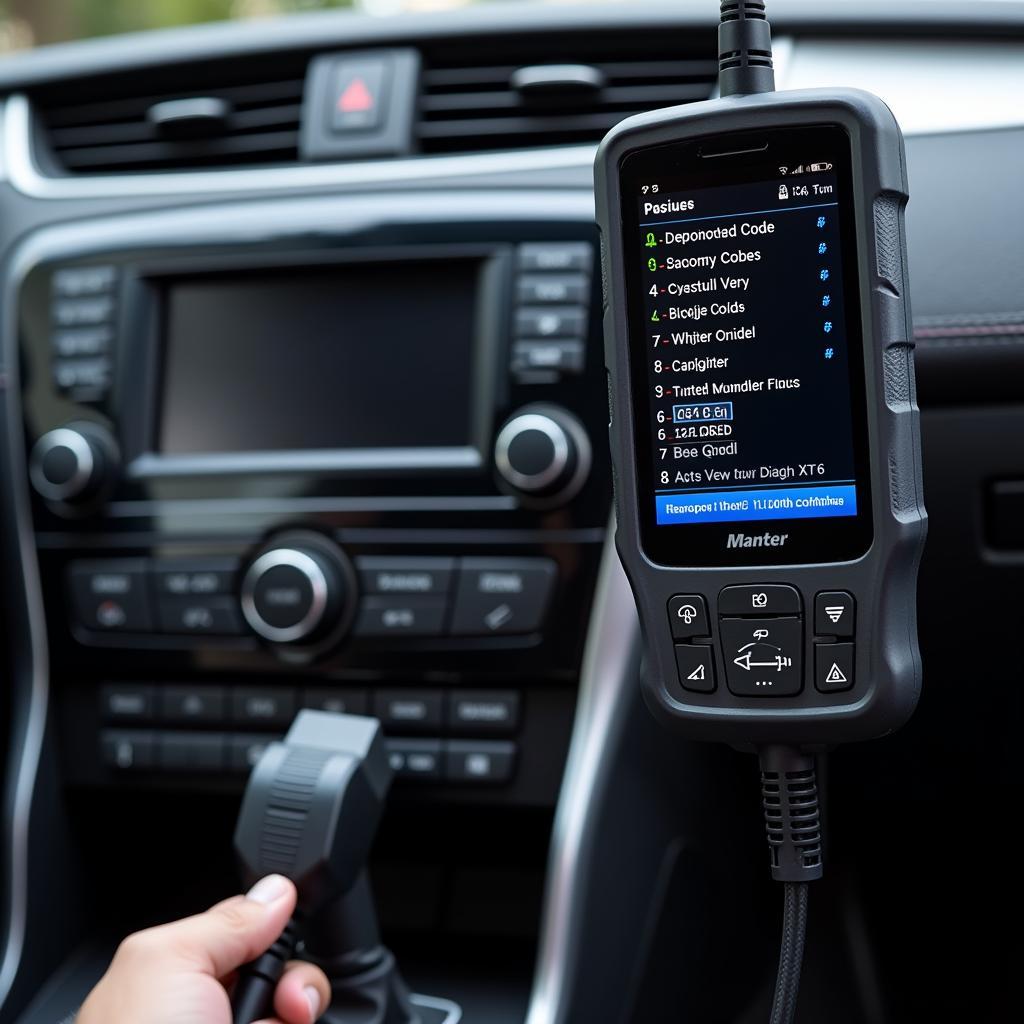Choosing the Best Car Diagnostic Equipment can feel overwhelming with countless options flooding the market. Whether you’re a seasoned mechanic or a car enthusiast looking to DIY, having the right diagnostic tool is crucial for identifying and resolving vehicle issues efficiently. This comprehensive guide will navigate you through the essentials of car diagnostic equipment, helping you make informed decisions for your specific needs.
Understanding Car Diagnostic Equipment
Before diving into the specifics, let’s clarify what car diagnostic equipment is and why it’s essential. In essence, it acts as a window into your car’s computer system, translating complex data into understandable codes and readings. This information allows you to pinpoint the root cause of malfunctions, saving you time and money on unnecessary repairs.
 Modern Car Diagnostic Scanner
Modern Car Diagnostic Scanner
Types of Car Diagnostic Equipment
Car diagnostic equipment comes in various forms, catering to different levels of expertise and budgets. Here’s a breakdown of the most common types:
1. OBD-II Code Readers: These handheld devices are the most basic and affordable option. They plug into your car’s OBD-II port and retrieve basic diagnostic trouble codes (DTCs), giving you a general idea of what might be wrong.
2. Advanced Scan Tools: A step up from code readers, these tools offer more in-depth diagnostics, including live data streaming, actuator tests, and system-specific diagnostics. They are ideal for professional mechanics or experienced DIYers.
3. Oscilloscopes: For the most comprehensive analysis, oscilloscopes provide a visual representation of electrical signals within various car systems. This level of detail is typically required for advanced diagnostics and troubleshooting complex electrical problems.
 Mechanic Using Oscilloscope in Garage
Mechanic Using Oscilloscope in Garage
Factors to Consider When Choosing Diagnostic Equipment
Selecting the right car diagnostic equipment involves considering several key factors:
1. Your Skill Level: Beginners might find basic code readers sufficient, while professionals require the advanced capabilities of scan tools or oscilloscopes.
2. Vehicle Compatibility: Ensure the equipment you choose is compatible with the make, model, and year of your vehicle. Some tools specialize in specific car brands, while others offer broader compatibility.
3. Software Features: Consider the software features offered, such as live data streaming, graphing capabilities, and printable reports. These features can significantly enhance your diagnostic process.
4. User Interface: A user-friendly interface with clear menus and intuitive navigation is crucial for efficient operation, especially for beginners.
5. Budget: Car diagnostic equipment prices vary widely. Determine your budget and prioritize features that align with your needs and expertise level.
Benefits of Investing in Quality Diagnostic Equipment
Investing in quality car diagnostic equipment offers numerous benefits:
1. Accurate Diagnosis: Precise diagnostics lead to effective repairs, saving you from the frustration of trial-and-error troubleshooting.
2. Cost Savings: By identifying the root cause of problems, you can avoid unnecessary repairs and costly replacements.
3. Time Efficiency: Streamline your diagnostic process, allowing for quicker identification and resolution of issues.
4. Enhanced Knowledge: Familiarizing yourself with car diagnostic equipment deepens your understanding of your vehicle’s systems and operations.
Top Car Diagnostic Equipment Brands
The market offers a vast selection of car diagnostic equipment brands. Here are a few reputable names known for their quality and reliability:
- Autel
- Launch
- Foxwell
- BlueDriver
- Innova
Remember to research and compare different models within these brands to find the best fit for your specific requirements.
Conclusion
Choosing the best car diagnostic equipment is an investment that empowers you to take control of your vehicle’s maintenance. By understanding the different types, considering key factors, and exploring reputable brands, you can make an informed decision that meets your needs and budget. Whether you’re a professional mechanic or a car enthusiast, the right diagnostic tool will undoubtedly prove invaluable in keeping your vehicle running smoothly for years to come.
FAQs about Car Diagnostic Equipment
1. What is the OBD-II port and where can I find it?
The OBD-II port, short for On-Board Diagnostics, is a standardized 16-pin connector found in most cars manufactured after 1996. It’s usually located under the dashboard on the driver’s side.
2. Can I use any car diagnostic equipment on any car?
Not necessarily. Vehicle compatibility varies depending on the make, model, and year. Ensure the equipment you choose supports your specific vehicle.
3. Do I need to be a mechanic to use car diagnostic equipment?
Basic code readers are user-friendly and require minimal technical knowledge. However, advanced scan tools and oscilloscopes might demand a deeper understanding of car systems.
4. Can car diagnostic equipment fix my car’s problems?
While diagnostic equipment helps identify issues, it doesn’t perform repairs. It provides the information you need to determine the necessary repairs.
5. How often should I use car diagnostic equipment?
It’s a good practice to scan your car for codes periodically or whenever you notice unusual performance issues.
If you’re looking for more specific guidance on choosing the right car diagnostic equipment, consider checking out these resources on our website:
- The Best Window Car Diagnostic Code Reader
- Best Offline Car Diagnostic Software
- Best 2018 Car and Truck Diagnostic Equipment
Need help finding the best diagnostic equipment for your needs? Contact us on WhatsApp: +1(641)206-8880, Email: [email protected]. Our team is available 24/7 to assist you!

Leave a Reply